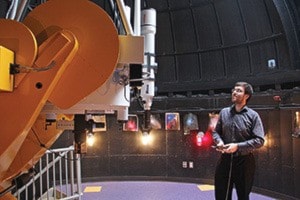The University of Victoria’s “shining jewel” perches atop the Bob Wright Centre.
“It’s my favourite room in the world,” says Steve Mairs, PhD student and outreach supervisor for the astronomy department – a role he took over last fall. The largest optical telescope on a Canadian university campus, it features a 32-inch mirror. It is the biggest and best and alongside its critical use in astronomy studies and research, the public aspect is just as important and fun.
“That gives you an amazing opportunity to see things,” Mairs said of the size. Winter is a particularly good time for star gazing, though anytime “it’s just beautiful through this thing.”
Mairs calls astronomy the “gateway science” for kids coming here – he leads school groups from pre-Kindergarten to those anticipating post-secondary schooling.
The massive telescope can pinpoint objects in deep space with the click of a computer mouse. A push of a button on the remote and the massive machine manoeuvres its way to point at its destination.
“We’ve handed (the remote) to kids who are four years old and they’ve used it correctly, under our direction,” Mairs said.
During the weekly open houses each Wednesday night, a swath of people take to the rooftop telescopes along with the grand one inside. They’re led in the stargazing by senior undergrads who come to answer all science-related questions.
Among those trained to tell the old constellation stories and address scientific questions is Nic Annau, an undergrad who started working the open houses in fall 2013.
“We have a few regulars,” Annau said. While the obvious draws are students from other sciences, they come from every corner of the campus, and beyond.
“Often students will hear about it and they’ll bring their parents,” Annau said. “I think a lot of it is the discussions. We have three stations set up, two observing stations and then a Q&A session in the lobby.”
The public and fellow students pose many questions, from basic to complicated – the kind of question where the post-grads consult with each other to come up with the answer.
And there’s always something to look at, offerings change regularly and there’s always the different phases of the ever-changing moon.
Annau’s fondness for the telescope and outreach sessions mirrors Mairs’s.
“I love the telescope. The telescope is a lot of fun,” Annau said. “It’s a lot of fun to show people how cool the telescope is too, it’s an amazing piece of technology.”
It feels good to give back, and not just because – as Mairs points out – as an astronomer, research funding comes from grants.
“This is one good way to give back to the community, for the community paying into our jobs,” he said.
The grand prize though, is the interest kids offer in return.
Astronomy has a magic more readily accessed than other sciences, especially with the UVic equipment available.
“It’s a phenomenal resource … Kids can get really, really interested in astronomy. It’s about pushing forth that next wave of inspiration,” Mairs said. “I call astronomy the gateway science. You show (students) a galaxy for the first time and their eyes explode.”
It opens kids and adults beyond their internet-found images and opens them to the other inter-related sciences.
“It’s a good opportunity to teach people where we stand with knowledge of our solar system. Everyone I’ve talked to is even a little bit interested,” he said. “If we can make that flourish and grow, we’re doing our job.”
Even on the common cloudy night on the south Island, they’ll still share stories, and check out images.
“We can still check out the instrumentation and equipment and talk about space,” Mairs said.
During the open houses each Wednesday night, guests range from 20 to 30 on a regular night with a jump to 60 to 70, with special events drawing upwards of 250. They’re coming to view the stars with some of the best minds in the field.
UVic astronomers are world-renowned for research involving the formation of galaxies, stellar structure and evolution, and theoretical and observational cosmology. Victoria even boasts the largest per capita concentration of astronomers in Canada.
They want to share that love of planets, nebulae and star clusters.
“We have extraordinary talent here. Having the biggest telescope on a university campus can really draw students,” Mairs said. “That’s our job, getting people to look up for the first time. It is truly stunning what we can see through this scope.”
Free open houses run rain or shine Wednesdays from 8 to 10 p.m. (from 9 to 10 p.m. May through August).
Learn more at uvic.ca/research/centres/arc/outreach online.
